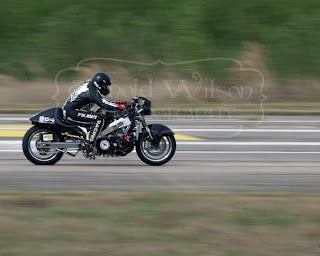1. Know the sport. In order to gauge where the action will most likely be, you have to understand the rules of the sport.
2. Anticipate the action. You must be prepared to take the shot about a second before the best action. Waiting until the action occurs to press the shutter will be too late, due to shutter lag.
3. Be prepared. Set up the shot between the bursts of action. Locking in focus and exposure in advance will help diminish shutter lag.
4. Increase shutter speed. Use shutter-priority (Tv) or your camera's preset action mode (if your camera has one), to reduce movement blur and shutter lag.
5. Capture the emotion. Stray from the action to capture the emotion on the player's and fan's faces.
Do not get discouraged. Capturing action shots takes a lot of practice. It is not uncommon to take hundreds of photos before getting one good one.
Explore more at: arnoldwilsonphotography.com
Wednesday, July 13, 2011
Monday, May 30, 2011
HAVE YOU THANKED A SOLDIER TODAY?
As Memorial Day 2011 comes to a close, I am reflecting on what exactly Memorial Day means to me. For many it is a time for families coming together, for others it is an opportunity for a mini vacation, and then for some it is just a 3 day weekend. But for all soldiers, both past and present, and the families of fallen soldiers, Memorial Day holds a whole different meaning.
For the veteran: it is a day of celebration for those who went and returned; it is a day of remembrance for those who went and did not return; it is a day of tribute to the soldier and his or her family for their sacrifice; it is a day for all non-veterans to honor and appreciate the service of all veterans . . . past, present, fallen.
Have you thanked a soldier today? It is never too late. Truly, every day should be considered Memorial Day.
Explore more at: arnoldwilsonphotography.com
For the veteran: it is a day of celebration for those who went and returned; it is a day of remembrance for those who went and did not return; it is a day of tribute to the soldier and his or her family for their sacrifice; it is a day for all non-veterans to honor and appreciate the service of all veterans . . . past, present, fallen.
Have you thanked a soldier today? It is never too late. Truly, every day should be considered Memorial Day.
Explore more at: arnoldwilsonphotography.com
Tuesday, April 12, 2011
HIPPITY HOP SPECIAL
Easter is on the way, the flowers are blooming, and it is a great time to get family portraits taken.
Arnold Wilson Photography is currently offering a 30 minute session with your choice of a one pose print package, which includes one 8x10, two 5x7 and 8 wallets, or a CD of four high resolution images for $60.
My Hippity Hop Special lasts only until April 23, so call
281-309-8396 to book yours session today!
My work is on display at: arnoldwilsonphotography.com
Arnold Wilson Photography is currently offering a 30 minute session with your choice of a one pose print package, which includes one 8x10, two 5x7 and 8 wallets, or a CD of four high resolution images for $60.
My Hippity Hop Special lasts only until April 23, so call
281-309-8396 to book yours session today!
My work is on display at: arnoldwilsonphotography.com
Monday, March 28, 2011
THE TEXAS MILE
I had the opportunity again to travel down to Goliad Texas this past weekend for the running of The Texas Mile. For those who have never heard of The Texas Mile, it is a 3 day Motorsports event, in which participant have one mile to achieve the highest speed they can, in hopes of making into the 200+ club.
Here are some of the shots I got this year:





Explore more at: arnoldwilsonphotography.com
Here are some of the shots I got this year:





Explore more at: arnoldwilsonphotography.com
Wednesday, March 23, 2011
TAKE AMAZING LANDSCAPE IMAGES
There are two significant details in any landscape photograph:
- Image composition
- Natural light
Image composition is all about how the elements in the scene are arranged. By using foreground objects and a small aperture, the entire scene will be kept in focus, creating a sense of depth. Attention can be directed toward the subject of the image by creating a natural frame with elements from around the scene. Trees are a great source for natural frames. Also the viewer can be drawn into the image by using leading lines into the main part of the scene, such as roads, rivers, or railroad tracks.
Natural light has three basic qualities: intensity, direction, and color.
The intensity of the light refers to the strength. Direct light creates a hard light source and strong shadows. Diffused light from a cloudy day creates a soft light and more even tones. The direction of the light refers to the placement and comes from three different paths: front, back, or side. Light coming from the front creates a flat, dull appearance. Light coming from the back creates a silhouette appearance with dark shadows. Side lighting produces texture and shading.
The color of light varies depending on the time of day, the atmosphere conditions and the time of year. Early morning and late afternoon, both produce light from an angle. The color of morning light is cooler with deeper purple and blue, whereas the color of afternoon light is warmer with deep red and orange. The light of spring and summer are vibrant, with the light of winter being harsher. Autumn produces warm light of orange, brown, and gold. A damp day followed by a cold night will can produce an eerie fog or low mist.
How each of these details are developed and revealed can result in outstanding landscape photos.
Explore more at: arnoldwilsonphotography.com
- Image composition
- Natural light
Image composition is all about how the elements in the scene are arranged. By using foreground objects and a small aperture, the entire scene will be kept in focus, creating a sense of depth. Attention can be directed toward the subject of the image by creating a natural frame with elements from around the scene. Trees are a great source for natural frames. Also the viewer can be drawn into the image by using leading lines into the main part of the scene, such as roads, rivers, or railroad tracks.
Natural light has three basic qualities: intensity, direction, and color.
The intensity of the light refers to the strength. Direct light creates a hard light source and strong shadows. Diffused light from a cloudy day creates a soft light and more even tones. The direction of the light refers to the placement and comes from three different paths: front, back, or side. Light coming from the front creates a flat, dull appearance. Light coming from the back creates a silhouette appearance with dark shadows. Side lighting produces texture and shading.
The color of light varies depending on the time of day, the atmosphere conditions and the time of year. Early morning and late afternoon, both produce light from an angle. The color of morning light is cooler with deeper purple and blue, whereas the color of afternoon light is warmer with deep red and orange. The light of spring and summer are vibrant, with the light of winter being harsher. Autumn produces warm light of orange, brown, and gold. A damp day followed by a cold night will can produce an eerie fog or low mist.
How each of these details are developed and revealed can result in outstanding landscape photos.
Explore more at: arnoldwilsonphotography.com
Thursday, March 17, 2011
5 TIPS FOR BETTER PHOTOS
1. Get close to your subject. Unless shooting a landscape, use all your available space by either moving physically closer or using the zoom feature. Eliminate most of the background distraction out of your shot, by allowing the subject to take up the whole frame. It is better to crop and resize a good close-up then to try to blow up a distant subject.
2. Check your composition. When framing the shot, place the subject off center so that they occupy a third to one half of the total composition. Look at the subject as a shape or form to determine the best angle and never put the horizon in the center of the frame.
3. Steady the camera. Camera movement will result in blurry photos. If you do not have a tripod to place the camera on, plant your feet firmly, tuck your elbows in close to your body, and slowing press the shutter button in one fluid motion.
4. Vary the light source. The closer the subject is to the light source, the stronger the shadows and contrast. Direct light, whether natural or flash, creates a hard light source and strong shadows. Diffused light, whether natural or flash, creates a soft light and more even tones. Natural light produces the best colors, especially with skin tones, so when working indoor, try to use the natural light coming from a window.
5. Look for contrasts between colors. Think in terms of shades of white, gray, and black in a black and white photo. One-color subjects should show great contrasts between the shades.
Explore more at: arnoldwilsonphotography.com
2. Check your composition. When framing the shot, place the subject off center so that they occupy a third to one half of the total composition. Look at the subject as a shape or form to determine the best angle and never put the horizon in the center of the frame.
3. Steady the camera. Camera movement will result in blurry photos. If you do not have a tripod to place the camera on, plant your feet firmly, tuck your elbows in close to your body, and slowing press the shutter button in one fluid motion.
4. Vary the light source. The closer the subject is to the light source, the stronger the shadows and contrast. Direct light, whether natural or flash, creates a hard light source and strong shadows. Diffused light, whether natural or flash, creates a soft light and more even tones. Natural light produces the best colors, especially with skin tones, so when working indoor, try to use the natural light coming from a window.
5. Look for contrasts between colors. Think in terms of shades of white, gray, and black in a black and white photo. One-color subjects should show great contrasts between the shades.
Explore more at: arnoldwilsonphotography.com
Monday, February 14, 2011
HAPPY VALENTINE'S DAY
A box of chocolates . . . $30
A dozen long stem roses . . . $100
Showing her you love her all year long . . . priceless!
Happy Valentine's Day!
Explore more at: arnoldwilsonphotography.com
A dozen long stem roses . . . $100
Showing her you love her all year long . . . priceless!
Happy Valentine's Day!
Explore more at: arnoldwilsonphotography.com
Subscribe to:
Comments (Atom)